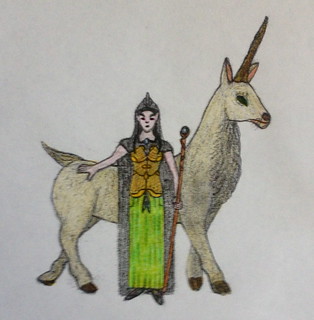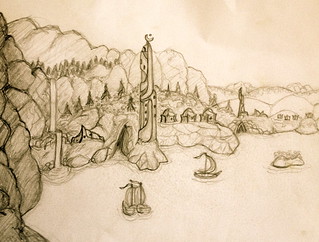Elves
The Enari look passingly Human but that observation overlooks a host of unusual characteristics. They speak the language Enara. They are called 'Elves' in Eriman and 'Fay' in Narman. Adventuring Elves can be Warriors, Thieves, Mages, Specialist Mages or Clerics (known as Ar-U-Mari which translates as 'Cosmic Guide').

Description
Fully grown Elves are between 5'2" and 6' tall and weigh 83 to 200 pounds. They are gracile compared to Humans and have fine faces which include gently pointed ears. They have long hair growing from their scalps but body hair is fine and transparent. Hair and iris colour changes as an Elf ages. In youth they have coppery-brown hair and green irises. In maturity they have golden-blond hair and blue-grey irises. In old age they have silvery-white hair and violet irises. The overall look of Elves is deemed enchanting by many but creepy by some. They can live as long as 500 years. They have exceptional resistance to infection (such that Fatal ones are only Severe and Severe ones only Mild). Elvish temperament ranges from frivolous to serene. They prefer temperate lands of meadow and woodland. Elves are most refreshed by naps of a few hours each (one in the day and two over night).
Culture
The Elves have an intense sense of belonging to the world in which they live. Elvish religion venerates the Universe as a whole and the Elves regard themselves as a fundamental part of it. Elves hold that the spirit following death becomes one with the spirit of the Universe. As such the concept of separate and aloof gods and goddesses is an alien one to Elvish culture. Only the most renowned of past Elves ever manifest as distinct spirits and then only temporarily to act on behalf of universal oneness. This perspective grants most Elves a sense of humility as individuals but in some it becomes an arrogance on behalf of all Elves.
They live in family groups that are well aware of how they are connected by blood and marriage to many other such groupings. Elvish society has basically two stratum - nobility and freeborn (in the sense that commoners are free of all but the most basic of civic obligations). Entry into the nobility for a freeborn Elf is a matter of simply marrying into nobility which any well-regarded Elf can do over time. As such the nobility are a significant proportion of the population and the distinction is regarded as a small one from day-to-day. There are trappings of nobility however such as the service of a family Pixie (a diminutive and enchanting form that only Elves can understand). Loyalty to the master or mistress of a household is important and a directive from such a person is binding (if rare). All Elves owe allegiance to the Elvish Monarchy and (once more) a royal decree is sacrosanct. Nonetheless the life of most Elves is one of freedom of movement and life-decisions. This even affects wartime conduct in that Elves prefer rapidly shifting tactics by small skirmishing bands.
The Elves nowadays live in two distinct nation-states which tend to be isolationist. Haven is what is left of the original Elvish empire and is located on the shores of the Great Ocean. Its territory includes Haven Island, Greenwood and a portion of the Hills of Fog. Its size was reduced by royal decree and to this day only the monarch has a full understanding of that decision. It however maintains a smattering of trading posts across coastal Westara. The inhabitants of Haven are known as the Eldenari (Meadow Elves). The Woodland Realm is located in the Greatwood Forest and owes nominal allegiance to the monarchy of Haven. It was founded by those who most objected to the ceding of territory to Humans who had once been guest-workers of the Elves. Its inhabitants are known as the Evenari (Wood Elves).
Technology
Elves draw on what natural mineral and plant substances they can from the territory they rule. They are renowned workers of wood, clay and sandstone. Homes provide fine shelter but are artfully designed to blend inside with outside. They can persuade trees to grow in particular shapes and the standard Elvish home is produced by a twisting together of several young trees into an elegant dome. More important or shared structures are incorporated into the canopy of grander trees set among gardens. Finally shrines and tombs are set in the ground under tree roots and can last a long time even once abandoned - inside wall murals depict a peaceful home life while domed ceilings show ghostly Elvish faces merging into an incandescent mass.
Elvish territory lacks natural reserves of metals or harder stones. While they can address this by trading they will also magically transmute (say) wood to stone and glass to steel. Such magic is done sparingly and its products are then cherished for generations. Elvish designs emphasize natural lines and curves. Civic and defensive structures have been constructed from huge blocks of timber that were grown into particular shapes and fitted together perfectly then magically transmuted into stone. Like all Elvish architecture they lack right-angles and curve into the sky. The motif of ivy occurs in much art and craft. Elvish music is improvised and meandering. It uses vocals, wooden flutes and ceramic wind chimes.

Clothes
The Meadow Elf troops of Haven wear Elvish chainmail and wield long sword and short bow except for Unicorn riders who also carry spears. They wear grey uniforms. Ar-U-Mari clerics accompanying the troops wear golden Elvish chainmail and green garments decorated with white flower while Elvish mages wear silver Elvish chainmail and blue garments decorated with stars. The Wood Elf militia of the Woodland Realm wear iron-studded bark-fiber jerkins along with garments of natural greens, browns and russets. They wield long sword and short bow except for Griffon riders who also carry spears. The long swords of the Elves have a distinctive one-bladed design. Elves are renowned as archers.
In civilian life Elves will wear clothes similar to those described (sans armour). As self-sufficiency is an Elvish value there is a tendency however for all adult Elves to carry some arms. Mottled grey cloaks are popular for travel. Clothing emphasizes the lines of the body in motion. Jewellery is delicate and worn sparingly but clothing itself has elegant decorative patterns worked into it. Distinctive crested caps and hoods suggest a connection to the over-arching universe.
Food
Elves only consume things taken from living things that allow those living things to continue living. Death is something Elves are happy to bring only to those who deserve it. So Elves will eat fruit and berries but not root vegetables, tree nuts but not ground nuts, grass seeds but not grass stems, mushrooms but not the fungal mesh that spawns them, eggs and milk but not flesh, honey but not bees. Elvish food emphasizes delicate flavours and textures and is nourishing but never overfilling. One exception to this is the famed and very decadent omelette made from Griffon eggs and Unicorn cheese. This is the centrepiece of any Elvish feast. Elves also enjoy a sparkling cider bottled under starlight which they find helps them contemplate things far away and long ago. Elves are much more likely to gather wild food rather than cultivate crops. If an Elf does consume meat they will become drunk on it.
Reproduction
An Elf can consciously inhibit fertility. Thus just by thinking they can ensure that a sex act is purely recreational. As a result some Humans think that Elves will be promiscuous. In truth Elves are very choosy. Courtship is slow and expressive. Both love and cultural factors are considered. An Elf may have a few concurrent lovers. One may be a cohabiting partner with whom they have children. Another an occasional paramour they visit now-and-then. These can be both mixed and same-sex relations.
Gestation for Elves takes 18 months but birth is quick. The Elfling is very small at birth and can only breath in water. It is instantly submerged in a liquid consisting of spring water and amniotic fluid that is held within a 'birth pod'. Traditionally these birth pods are bowls made from half of a hollow nut of massive size (1'6" to 2' long) but now they are frequently made of carved wood or clay. The infant spends the next 18 months in the pod as the composition of the fluid is slowly changed and its level lowered so that eventually it is sitting in only inches of pure spring water and can now begin life as an air-breathing toddler. During that time it is only removed from the pod for suckling (which somehow overcomes its need to breath). Elvish nature and culture is such that the Elvish population has been static for all of history.

Half-Elves
Elves and Humans can have children but such liaisons are rare. Coupling between existing Half-Elves is much more common - allowing for more normal lives together - and the majority of Half-Elves are the children of Half-Elves. They lack the ability to control fertility yet tend to be flirty.
Half-Elves are the same size as Humans and otherwise have much diluted Elvish characteristics. They lack the infection resistance of Elves. They can live to almost 250 years. It is the marked difference in lifespan between the two that has made Half-Elves rare and likewise makes most seek each other to form relationships. The majority of Half-Elves live in Human society. Half-Elves can be Warriors, Rangers, Mages, Specialist Mages, Clerics, Druids, Thieves and Bards.


<< Home